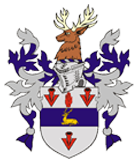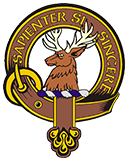Battles of Invernhaven And Perth – 1300s
A fostership of sorts seems to have been established by the other Chattan clans on behalf of the Davidsons, the latter having lost their chief and seven of his sons at Invernahavon. As the two remaining children were not old enough to assume the Chiefship, the office or, at least, its stewardship, may have temporarily passed to the MacIntosh. Another possibility is that the office may simply not have been recognizable for some time. There are one or two sources that seem to suggest that the older of the two children was female. For whatever reason, though, it should be kept in mind that gender roles were very specific at that time, hereditary title did not pass to her. Later on – possibly when the younger of the two children, being male, was old enough to support it – we see a re-emergence of the Chiefship. However, there is debate about this aspect of the history and it is yet to be proved, so we will leave further discussion of it for a later date.
All the same, there is one thing here that contributes to the core of the matter and is noteworthy for our purpose: the subject of direct surname inheritance. In the case of fostership, “Davidson” would have, and likely did, become more a “sept” name of the Confederation or perhaps even Clan MacIntosh until the rightful heir or otherwise worthy figure could reclaim the Chiefship and its arms. At this point in history, in fact, some traditions held that until a “noble name” (read this as hereditary title) could be taken in an official and permanent capacity, no one was allowed to use it in a formal manner. The point is, in either case, the “disappearance” of the Davidson name 12 and chiefly lineage from the history books was likely linked more closely to naming standards coincident with events than to an overall annihilation of the Clan and removal of its senior members resulting from these events. We already know the chiefly lineage did not indeed “die out” until 1917, and obviously did not do so wholly even then, since we presently have a Chief who was able to establish heredity to that line.
Still, what we can give credence to is the notion of being pushed into “relative obscurity,” as the literature terms it. Generally, when used in this context it refers to an overall lack of political influence and/or ability to field an army, and absence of financial strength. As we’ve seen, the term could be correct here if used in this way. However, it is widely suggested that its actual use describes the decimation of literal numbers resulting from the aforementioned battles, leaving behind too little a populace to be “fruitful and multiply.” In this usage, the prevailing literature can already be dismissed in large part. History shows we suffered severe losses at Invernahavon. If there is truth, as there seems to be, behind a Chattan fostership of the remaining Davidsons or in the chiefly line being “paused” until the rightful heir was old enough or placed by other means, there would have been a power vacuum to fill and, more importantly, it would not have been immediately filled by a Davidson. Therefore, we would not have had a direct impact on history until the Clan had reestablished itself. In short, it would have been difficult for us to be a formal and singular presence at the North Inch, only short years later.
On this same note, it has been assumed and asserted by some historians that the Clan disappeared altogether after the North Inch, and for hundreds of years. This too is defeated when we view the many historical references to the Davidsons being “proliferate” and “involved in the affairs of State and of the Highlands” from points in the early 15th century onward. There is also a Davidson presence at the Battle of Harlaw in 1411 (some 15 years later), our participation in the signing of the Bond of Union in the early 16th century where the formation of Clan Chattan was formally recognized, and so on. Perhaps, in the words of Mark Twain, “rumors of our death (well, disappearance) have been greatly exaggerated.” The flaws in previous accounts of our history keep stacking up!
But, before we get too far afield, let’s get back to the tale. Allison and, it seems, the majority of the NTS folk and other academics support the Chattan versus Cameron position. In Culloden Tales, it is not even a supposition that this is the case – Allison states it. That Invernahavon was not the last encounter between Chattan and its elements and the Camerons is certain. However, as we have seen, there is absence of record between Invernahavon and the Battle of the North Inch – nearly twenty years’ worth. Allison, on the other hand, points to select NTS historians’ beliefs that a series of fierce skirmishes and armed eruptions between 1382 and 1396 in the clans’ overall, geographic shared area may be proof that the two groups kept the conflict very much alive.

